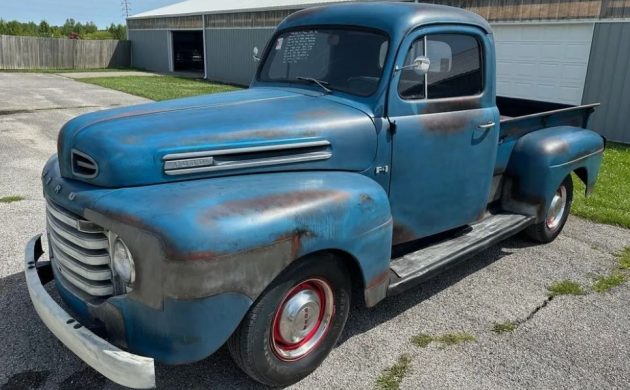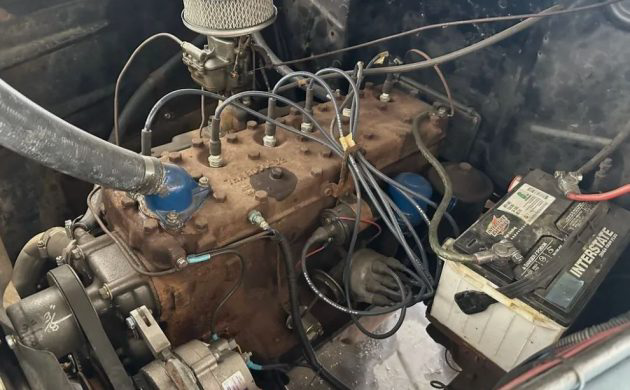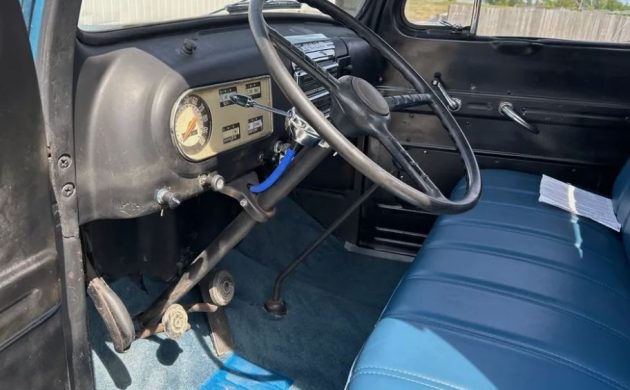
Ford likely had no idea that its 1948 introduction of the “Bonus Built” F-series pickup would spark the multi-decade development of one of the most popular vehicles in automotive history. The company did spend $1 million on the cab’s design – a fortune in those days – earning the F1 the moniker “Million Dollar Truck” Some of its new features included wider interior dimensions and doors; taller greenhouse for better visibility; a deeply cushioned, adjustable bench seat; and “level action” bushings and springs to insulate the cab from the frame’s wanton movements. Speaking of the frame, no longer was it borrowed from a passenger car; instead, it was purpose-built with re-engineered shocks for a better ride over rough roads. Country Classics has listed this patina-finished 1949 Ford F1 pickup here on eBay. Bidding has reached $10,100 – not yet enough to meet the reserve. Country Classics is located in Staunton, Illinois, and if you’ve never visited, it’s worth a trip – there’s a lot to see!

The engine is Ford’s 226 cu. in. flathead six-cylinder, good for 95 hp, and mated to a floor-shift three-speed manual. There’s a new aluminum radiator and new wiring along with a conversion from 6v to twelve. Unfortunately, the original air cleaner assembly has been replaced with a generic aftermarket item. The seller mentions that this truck runs and drives well as is, but suggests a swap to a V8, and I don’t think he means the 239 cu. in. that Ford also made for ’48…

Here’s that cab finished out in blue vinyl upholstery and blue carpet. A vintage-look heater is installed along with a host of auxiliary gauges. Ford touted its one-piece windshield and “three-way” ventilation system, which really meant vent windows, a cowl vent, and a heater. The cab came with an ashtray and driver’s side sun visor – these were extra-cost options at other makers.

Rusted areas – the cab corners, lower quarters, portions of the front fenders – have been patched with shaped, riveted panels. What we don’t know is what’s under those patches. The underside is scaled with rust, but the bed has been refurbished with new wood. F1 trucks of this vintage are selling in the $25k to $35k area for good driver-quality examples; this seller’s reserve is going to be close to $18k, given his listing at Hemmings. What do you think – is this early F-series worth it?
Pfft, yeah, when a million dollars was considered a lot of money. This has a snowballs chance in Phoenix in July of staying like this. Country Classics has been around a while, and generally deals with regional finds. Located in central Ill., farm country, and more than likely where this came from. Being such an iconic style, the sky is the limit, everyone with their own rendition, but stock like this just won’t cut it. Don’t get me wrong, before the squarebody, this was exactly what I wanted, but I didn’t have $10 grand to spend. If this site is any indication, there’s still plenty of interest for a stock pickup like this. Next time around, not so sure. It’s a great find.
You sure don’t see them much nicer at this age. While I would prefer a V8 in that engine bay the six is just fine. Body work looks pretty basic; it’s in good shape, overall, for being 75 years old.
Of course, for me, it would get a driver-quality restoration. But then, it would be DRIVEN.
I’ve said my piece many times about converting to 12V so I won’t pursue it here. People do what they want to do and that’s just fine. I encounter at least one customer a day who wants to convert to 12V. I tell them what they need to do, and leave it at that. It’s quite interesting that they all ask the same questions, especially the ammeter.
You can run the Hot from the alternator right through the ammeter but remember, the ammeter is designed for a possible 30 amps while the alternator has a potential for 100 amps. Kind of like trying to fill a wash basin with a fire hose. Could cause a stench somewhat worse than someone “cutting the cheese.” I just tell them to run a shunt through the ammeter and route the main hot cable directly to the battery.
Easy-peasy but I know a better way…
Wouldn’t get all excited about the 12 volts, Michelle says they converted it from 12 to 6 volts. Sorry, but couldn’t resist that, especially about someone who makes one mistake per the 100 we make out here. Me, I’d paint it, fix up the interior, and put a V8 in it. No tire burner, just something to get down the road with all the new guys out there. Then I’d toss the crew chief into the navigator seat and hit the road.
Aw sugar. I fixed it, thanks Bob. PS My office is in Oregon City on High St, I think your brother lives here?
I had one in 69. Had a 265 Chevy Corvette engine with 2 4-barrels hooked up to the original transmission. Couldn’t take off without spinning the tires. The kingpins were shot and I was working 106 hours a week and it got towed and scrapped while I was out of town m
He lives on top the hill on South Arrowhead Drive.
I’d fix a few things and drive it!
In my garage, I currently have 2 light trucks from this era. One is restored to original condition, the other is a V8 (6.2LS) resto-mod on modern Escalade drivetrain. I love them both, but the original truck is driven only a few times per year, and the resto-mod gets driven at least weekly (in good weather).
As for the 6 vs 12v argument…. On really original rides I have kept the 6v system. On all the rest I went to 12v. I usually replace the ammeter with a voltmeter, but you can keep the original ammeter if you install a shunt.
I can’t believe all those patch panels, although done neatly and OK for a ratty driver there’s rust under them and a 6 banger 3 speed and still over 10K and asking 18K. This is a six cylinder rat rod truck, which is OK and I like it for 6K – 8K.
Whoa . . . does no one other than the author wonder what’s under the fake patina and pop-riveted patch panels?
Hey don’t knock pop rivet body work. Unless you’re really good at welding which I’m not; then this is the way to go. I’ve been guilty of it quite a bit over the years. It looks exactly like what it is: a patch over a hole. But it looks much better than a hole in my opinion. You just have to cut out the bad metal and Por15 the exposed metal. I also back coat the patch. I mean we ain’t talking concourse here. I favor ductwork sheet metal myself. In fact I just completed this red neck engineering method on a couple of holes on my 1999 Dodge pickup. And while I am at it I have to say that the work on this truck is first class PRBW; perhaps the best I’ve ever seen and certainly better than I have ever done. Now all that being said I would never do this to a vehicle that I wanted to have looking good. I paid a pretty penny to have a replacement panel professionally installed on my 1952 Plymouth a few years back. And they did a great job. But it would cost a small fortune to have the same areas that are hillbilly repaired on this truck done right. I guarantee you that somebody spent a lot of time on this. I wonder how many drill bits he went through?
I too have riveted in patch panels. The trick here is to take the edges of the panel and area to be covered down to bare metal and put Rustoleum primer on them. Properly primed and painted on both sides and you are good to go. Also, flat head counter sunk rivets will give a smooth look to your work.
Oh, and since I’m feeling extremely chatty today; I’ll toss in my two cents in about six to twelve volts conversion. I have had about a half dozen vehicles that use six volt systems. Still have one. I never had an issue with any of them. So I lean toward leaving it six volt for authenticity. But twelve volts gets you brighter headlights and if you’re going to be adding accessories like A/C then twelve is a must. So that’s my opinion for what it’s worth.
I fear I sound like a broken record, but I’d recommend keeping the 6. It’s got about the same horsepower as the legendary flathead V8, but with more low end torque and less propensity to overheat. It’s easier to work on and slightly smoother running, too. I guess if you insist on hot-rodding it, a modern V8 is OK, but a survivor like this really should be allowed to survive as built, IMHO.
I live near Staunton and I will simply say caveat emptor. Their reputation is less than stellar. Just sayin’.
Every once in a while I do a quick search of old Ford trucks, amongst other things on ebay, and every time I do I see this truck. It’s been listed for several months and that trend will continue for a long time as long as their ridiculous asking price doesn’t change.
It’s weird what people do to vehicles that hurt their value when their intention is to help it (I think?). If the interior wasn’t rattle canned black and if the body wasn’t oddly touched up and the patches put on, it would help. They should’ve left it as is, but it still wouldn’t be worth 18.
There’s simply little reason to do a 6V – 12V conversion anymore. If your cables are well maintained you are fine there. If you really need briggt headlights, modern 7″ LED replacements are readily avaiable in 6V for under $100/pair.
In 1977 I bought a 1952 Ford 1/2 ton for $270.00 at an auction. My father-in-law thought I was nuts paying that much for a 25 year old truck. I tried converting to an 8 volt battery. Created more problems than it solved so back to 6. Converted my 1949 Monarch sedan to 12 and it was fine, lots of Runtz voltage reducers. I have never seen a 6 cylinder Ford pickup in Canada. They are all flatheads here. For highway speeds I put in a newer rear end so it would do 65 without working too hard but did snap off a valve head on #4 cylinder at highway speed. Made a hell of a racket but stayed under the cylinder head and did not damage the piston. Drove it till 2018 without touching the body and it was quite a mess when we moved and had to sell it. This featured one makes mine look good but the new owner of mine restored it and its still going strong. Best vehicle I ever owned for durability.
I just checked, it was bid to $10,100 on eBay but the reserve was not met. The seller should take the 10 grand and run !
Leave it and drive it. Ok, maybe it needs a little TLC, but that’s it.